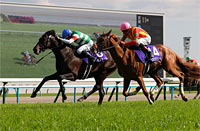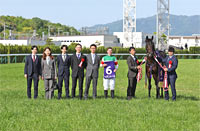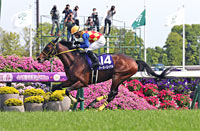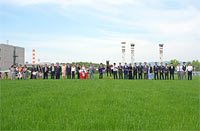Tenno Sho (Spring) (G1) - Data Analysis
Long-distance race steeped in tradition to be held at Hanshin Racecourse this year
The Tenno Sho (Spring) is contested on a turf course over a distance of 3,200m, making it the longest JRA flat G1 race. In six of the 10 races held since 2011, the winner and runner-up finished without any time difference. This suggests we cannot take our eyes off the runners in this race until they have crossed the finish line. In addition, this year’s race will be held at Hanshin Racecourse because Kyoto Racecourse, the typical venue, is undergoing maintenance work. For this reason, we have taken into account data for the Hanshin Daishoten (a long-distance graded race similarly held at Hanshin Racecourse) in our analysis below, in addition to the results for the Tenno Sho (Spring) in the last 10 years.
Predictions warrant caution
Looking at performances by runners over the last 10 years in terms of favoritism, we find that runners backed as race favorite achieved a Top 3 ratio of 40.0%, which may appear somewhat underwhelming. At the same time, runners in this group finished in the Top 2 in the last four years. From 2011 to 2016, runners backed as 2nd or 3rd favorite (and both in 2013) finished in the Top 2, so selecting a highly favored runner would seem to be the smart strategy. That said, five runners that were backed as 10th or lower have also finished in the Top 3. When making our predictions, we should therefore keep in mind that there is ample scope for dark horses to chase the top places in this race. [Table 1]
[Table 1] Performance by favoritism (last 10 years)
| Favoritism |
Performance
[1st-2nd-3rd-4th or lower] |
Win ratio |
Top 2 ratio |
Top 3 ratio |
| 1st favorite |
3-1-0-6 |
30.0% |
40.0% |
40.0% |
| 2nd favorite |
4-0-2-4 |
40.0% |
40.0% |
60.0% |
| 3rd favorite |
0-4-1-5 |
0% |
40.0% |
50.0% |
| 4th favorite |
1-1-2-6 |
10.0% |
20.0% |
40.0% |
| 5th favorite |
0-0-1-9 |
0% |
0% |
10.0% |
| 6th-9th favorite |
1-2-2-35 |
2.5% |
7.5% |
12.5% |
| 10th favorite or lower |
1-2-2-73 |
1.3% |
3.8% |
6.4% |
Performance by previous race has changed in recent years
Looking at performances by runners over the last 10 years in terms of the previous race, we observe that runners coming from the Hanshin Daishoten made up over 30% of our analysis group, yielding success ratios that are not very meaningful. However a total of 10 runners in this group finished in the Top 3. In addition, runners that had won the Hanshin Daishoten before entering the race delivered outstanding performance of [2-0-3-4] (Top 3 ratio of 55.6%). Because the Tenno Sho (Spring) will be held at Hanshin Racecourse this year, performance in the Hanshin Daishoten is of even greater significance this year than in typical years. In terms of success ratios, runners coming from the Osaka Hai (including in the years through 2016, when the Osaka Hai was held as a G2 race) achieved the highest scores, so runners in this group cannot be overlooked. In addition, 23 of the 30 Top 3 finishers had entered the Tenno Sho (Spring) after contesting either one of the two aforementioned races, or the Nikkei Sho. In other words, we should focus on runners whose last outing was about one month ago. [Table 2]
[Table 2] Performance by previous race (last 10 years)
| Previous race |
Performance
[1st-2nd-3rd-4th or lower] |
Win ratio |
Top 2 ratio |
Top 3 ratio |
| Osaka Hai |
3-3-0-7 |
23.1% |
46.2% |
46.2% |
| Hanshin Daishoten |
3-2-5-47 |
5.3% |
8.8% |
17.5% |
| Nikkei Sho |
2-2-3-44 |
3.9% |
7.8% |
13.7% |
| Other race |
2-3-2-40 |
4.3% |
10.6% |
14.9% |
Note: The Osaka Hai was held as a G2 race in the years through 2016.
However, Fierement and Glory Vase secured 1st and 2nd position in the 2019 Tenno Sho (Spring) after having contested their previous race in January. In 2020, Fierement secured a consecutive victory in the race after having run the 2019 Arima Kinen (The Grand Prix) in his last outing. If trends in recent years are anything to go by, we should focus on runners that enter the race with a substantial intervening period since their last race. [Table 3]
[Table 3] Top 3 finishers that came from races other than Osaka Hai, Hanshin Daishoten, and Nikkei Sho (last 10 years)
| Year |
Finish |
Horse |
Previous race |
| 2013 |
2nd |
Tosen Ra |
February 10 |
Kyoto Kinen |
| 3rd |
Red Cadeaux |
March 30 |
Dubai World Cup |
| 2015 |
2nd |
Fame Game |
February 21 |
Diamond Stakes |
| 2019 |
1st |
Fierement |
January 20 |
American Jockey Club Cup |
| 2nd |
Glory Vase |
January 13 |
Nikkei Shinshun Hai |
| 3rd |
Perform a Promise |
February 10 |
Kyoto Kinen |
| 2020 |
1st |
Fierement |
December 22 |
Arima Kinen (The Grand Prix) |
Track record in 3,000m+ G1 turf races is a key factor
In the Tennen Sho (Spring) races over the last 10 years, we find that Fenomeno, Kitasan Black, and Fierement all achieved consecutive victories in the race, suggesting that runners with an aptitude for long-distance races fare well. Looking at performances by runners over the last 10 years in terms of experience of finishing in the Top 3 of a 3,000m+ JRA G1 turf race, we note that runners with such experience achieved a Top 3 ratio of over 30% and have won the race in the last seven years. In other words, we need to raise our expectations of runners with previous success in long-distance G1 races. [Table 4]
[Table 4] Performance by experience of finishing in Top 3 of 3,000m+ JRA G1 turf race (last 10 years)
| Experience |
Performance
[1st-2nd-3rd-4th or lower] |
Win ratio |
Top 2 ratio |
Top 3 ratio |
| Yes |
8-5-4-38 |
14.5% |
23.6% |
30.9% |
| No |
2-5-6-100 |
1.8% |
6.2% |
11.5% |
Watch position when passing 4th corner in previous race
On the 3,200m turf course at Hanshin Racecourse, runners will run on the outer oval in the 1st lap and on the inner oval in the 2nd lap (which is the same as the 3,000m turf course). Because the Hanshin Daishoten is also contested on the 3,000m turf course, we can use that race as a reference point. Looking at performances by position when passing the 4th corner in the 2nd lap of the 3,000m Hanshin Daishoten held in the 10 years from 2011 to 2020, we find that the 10 previous winners all passed the 4th corner in 4th or higher position. In other words, the ability to pass the last corner of a long-distance race at Hanshin Racecourse in a leading position will likely determine success or failure. [Table 5]
[Table 5] Performance by position when passing 4th corner of 2nd lap in Hanshin Daishoten (from 2011 to 2020)
Position when passing 4th corner
of 2nd lap in Hanshin Daishoten |
Performance
[1st-2nd-3rd-4th or lower] |
Win ratio |
Top 2 ratio |
Top 3 ratio |
| 4th or higher |
10-6-6-29 |
19.6% |
31.4% |
43.1% |
| 5th or lower |
0-4-4-47 |
0% |
7.3% |
14.5% |
Looking at the last 10 Tenno Sho (Spring) races held at Kyoto Racecourse, we find that runners that passed the 4th corner in the 2nd lap in 4th or higher position delivered performance of [6-6-5-30], and made up over half the Top 3 finishers. This suggests that runners that can run in the leading pack when passing the last corner in a long-distance race (regardless of the racecourse) have a higher probability of winning. To judge whether or not runners have this capability, we should look at runners’ position when passing the 4th corner in the previous race, and keep in mind that eight of the last 10 winners passed the 4th corner in 4th or higher position in their previous race. [Table 6]
[Table 6] Performance by position when passing the 4th corner in previous race (last 10 years)
Position when passing 4th
corner in previous race |
Performance
[1st-2nd-3rd-4th or lower] |
Win ratio |
Top 2 ratio |
Top 3 ratio |
| 4th or higher |
8-5-5-58 |
10.5% |
17.1% |
23.7% |
| 5th or lower |
2-5-4-78 |
2.2% |
7.9% |
12.4% |
Note: Excluding cases when the previous race was held overseas.
Seek out the winner!
Check performances in Classic races
The last 10 winners comprised four 4-year-olds, five 5-year-olds, and one 6-year-old that defied the dominance of the younger horses. This suggests that we should focus on horses aged 4 to 6 to find potential winners. Another shared feature among the last 10 winners was that they had all experienced finishing in Top 3 of a Classic race. In other words, we should focus on horses aged 4 to 6 that have delivered strong performance in a Classic race. [Table 7]
[Table 7] Winners’ age and Top 3 finish in Classic race (last 10 years)
| Year |
Winner |
Age |
Top 3 finish in classic race |
| 2011 |
Hiruno d’Amour |
4 |
Satsuki Sho (Japanese 2000 Guineas) 2nd |
| 2012 |
Beat Black |
5 |
Kikuka Sho (Japanese St. Leger) 3rd |
| 2013 |
Fenomeno |
4 |
Tokyo Yushun (Japanese Derby) 2nd |
| 2014 |
Fenomeno |
5 |
Tokyo Yushun (Japanese Derby) 2nd |
| 2015 |
Gold Ship |
6 |
Satsuki Sho (Japanese 2000 Guineas) 1st,
Kikuka Sho (Japanese St. Leger) 1st |
| 2016 |
Kitasan Black |
4 |
Satsuki Sho (Japanese 2000 Guineas) 3rd,
Kikuka Sho (Japanese St. Leger) 1st |
| 2017 |
Kitasan Black |
5 |
Satsuki Sho (Japanese 2000 Guineas) 3rd,
Kikuka Sho (Japanese St. Leger) 1st |
| 2018 |
Rainbow Line |
5 |
Kikuka Sho (Japanese St. Leger) 2nd |
| 2019 |
Fierement |
4 |
Kikuka Sho (Japanese St. Leger) 1st |
| 2020 |
Fierement |
5 |
Kikuka Sho (Japanese St. Leger) 1st |
(Maya Takanami)
|



















